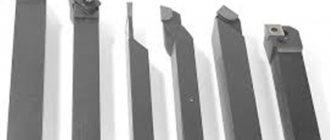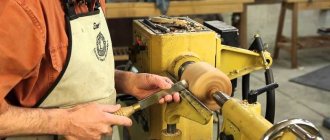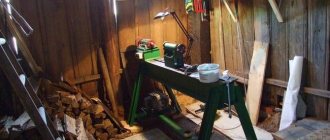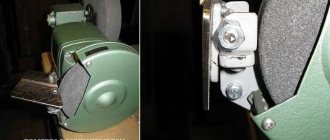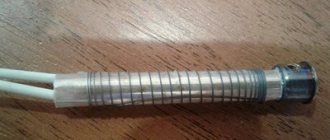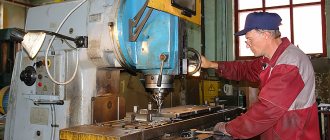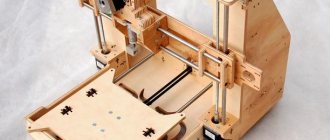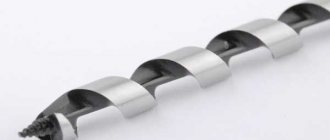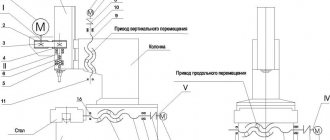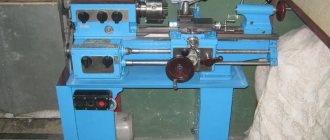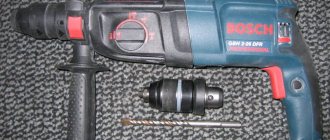Types of machines (for wood and metal)
Depending on the operations performed, functionality and size, lathes are divided into several groups. Each has its own characteristics in design and operation. Read also: Basics of turning, equipment and professional skills, what is turning?
Universal
The universal lathe is designed for initial roughing, as well as sharpening, cutting and drilling. Also, using this equipment, carvings are applied to a wooden object.
Lathe-screw
This type of lathe is designed for processing cone-shaped workpieces and for applying threads.
Turning and milling
Most often, this equipment is used for boring grooves. If such a machine additionally contains a copying device, this will allow the work to be completed faster and more accurately. Also, such machines help to obtain objects of completely unusual shapes, real works of art.
Desktop
This equipment is suitable for domestic use only. Such machines can be located in an apartment, in a garage, in a private house and perform the most standard operations for processing wood products. It is on such machines that folk craftsmen make the most necessary and beautiful items for their interior.
Finishing the workpiece
This method is used to process cylindrical elements of varying lengths, fixed between the centers of the tailstock and headstock. Accordingly, you have the opportunity to make any parts: from railing posts and table legs to tiny chess pieces. In particular, skilled craftsmen are skilled at making and sharpening billiard cues.
The first step of the job is to determine the location of the axle of the piece of wood to clamp it between the center of the tailstock and the driving center.
The second stage is to make a blank (from cutting a log or a square block of wood). This can be done in the 1000−1500 rpm mode. In this case, the chips should be removed from right to left using a grooved concave wide chisel to pre-process the reyer. If the workpiece is long, then roughing is carried out in several steps; the tool rest moves closer to the part as it is finished, without changing its height position.
When turning parts, there are tools of various shapes for processing shaped surfaces:
- hook,
- semicircular cutter,
- flat chisel,
- beveled chisel (or popularly - jamb),
- grooved chisel, etc.
Depending on the type of tool used and the stage of the work process, it is necessary to bring the tool rest closer to the workpiece from time to time. At the end of the process, when the part is ready, the final finishing is carried out:
- polishing,
- toning,
- grinding,
- waxing, etc.
The finishing touches occur when the support has already been removed.
Detailed study of the machine
All lathes are designed in a similar way and are built from the same components. Each unit in the machine performs its own function and has its own structural features.
bed
This is the basis of any machine. The bed is a cast piece of equipment and prevents excessive vibration, which can lead to wear on the machine and inaccuracy when processing the workpiece.
Apron
The apron transforms the rotational movement of the lead screw into the translational movement of the caliper. The movement from the running roller is used to mechanically move the cross slide. The lead screw is necessary when cutting threads, and the lead roller is necessary for all other turning operations.
The apron contains 4 cam clutches, which are responsible for the forward and reverse motion of the carriage and slide. The apron also has a blocking device that prevents the simultaneous activation of longitudinal and transverse transmission.
Caliper
The support is designed to secure and move the cutting tool. The caliper is located on the lower slide and the movement itself is determined by the rotation of the screw.
Headstock
The spindle head is one of the main components of any lathe. The accuracy of the location and movement of the workpiece depends on this detail. The headstock consists of: a housing, a spindle, bearings, a device for controlling the movement of the spindle, a button for turning the equipment on and off. The basis for all parts of the spindle head is its body. The body shape may vary depending on the machine model.
Tailstock
The thrust head is also attached to the frame and is necessary for securing the cutting tool. This is also the support for the right end of the workpieces. The support headstock is brought to the blank along the frame guides and fixed motionless with a bolt and nut.
Tool rest or incisor holder
Another basic part for a standard wood lathe. The convenience and safety of the entire process depends on it.
Operating principle
The basis of the machine is the bed. The headstock is located on it, and the electric motor is located on the inside. The engine rotates a spindle with a Morse taper, and a tailstock (support) is attached to the opposite side of the equipment.
A tool rest, which can rotate in any direction, is attached as close as possible to the workpiece and guides the cutter, supporting it. The machine can have manual gearbox adjustment or automatic. The most modern models have a variator, which allows you to adjust the speed.
Subtleties of choice
If working with wood is just a pleasant hobby and you don’t have a whole workshop with a full arsenal of all the tools at your disposal, then the choice of machine is critically important. There are a number of parameters, paying attention to which, the likelihood of an unsuccessful choice will decrease significantly.
What to look for when choosing
Most often, very compact devices, tabletop lathes, are purchased to satisfy the creative itch. Of course, in terms of accuracy and engine power, they cannot be compared with powerful industrial analogues, but the price of such devices is reasonable.
When choosing, you should pay attention to such machine parameters as:
- maximum permissible dimensions of the workpiece being processed. The documentation for the machine must indicate the turning diameter (the maximum size of the workpiece in the transverse direction) and the length of the bed (the maximum permissible length of the workpiece);
A compact lathe will not be able to process a long workpiece
- power - roughly speaking, the more powerful the device, the better, but with increasing power, the dimensions of the machine also increase. So you need to find a middle ground;
- the material from which the bed is made, as well as the material of the frame. From the point of view of stability, models with a steel frame and a cast iron frame can be considered optimal. True, the weight of such machines is quite large, so if you plan to frequently relocate it, then it is better to choose a lighter model;
Note! Machines in which the frame and body are made of light alloys can be easily moved from place to place with your own hands without outside help. On the other hand, they are not as durable as steel ones.
- rpm adjustment range. All modern machines can adjust the speed, so you should pay attention to the upper and lower limits of this range. Thus, low speeds are suitable when you need to roughly process a workpiece in the form of a parallelepiped, and high speeds will be used for finishing processing, when you need to obtain a smooth surface.
Basic elements of an industrial machine
As for the device, the key elements of a lathe include:
- cutter holder – allows you to securely fix the cutter and move it in 2 directions during operation (along the workpiece and in the transverse direction);
- headstock - in conventional machines it is located on the left (if the turner is right-handed). It consists of elements such as a drive mechanism and a spindle, the center of which rotates during operation, causing the workpiece to rotate.
Note! Instead of a spindle, a faceplate can be installed at the end of the headstock - a device that is necessary in the case of an end value.
- tailstock - used to fix the second end of the workpiece; its end rotates freely, so that nothing will interfere with the rotation of the workpiece.
Read also: Resanta sai 250 photos
From left to right: headstock, tool holder, tailstock
What kind of cutters will you need?
Even in order to make such a simple element as turned legs for a wooden table, you will need several different types of cutters.
It is advisable that an amateur turner have in his arsenal:
- semicircular cutters - they will be needed for rough processing, for example, in order to turn a workpiece in the form of a parallelepiped into a cylindrical one. Also, semicircular cutters can be used for finishing, small-width cutters (no more than 20 mm) can be used to create decorative grooves in the workpiece, and wide models (up to 50 mm) are used for processing large concave surfaces;
Cutting part shape
- a flat cutter can be used for chamfering and processing curves. The cutting part has a 2-sided sharpening and forms an angle of up to 70ᵒ with the side edge;
- to process internal surfaces (such products as turned wooden vases cannot be made without this), you will need shaped cutters;
- hook-shaped cutters can also be used.
If a suitable cutter is not at hand, you can always make it yourself from an old file or an ordinary wood chisel. An error of a couple of degrees when sharpening will not seriously affect the result of the work.
Sometimes you have to manually modify purchased cutters. For example, when it is necessary to make a slot in a workpiece, when using a conventional cutter, the side internal parts are quite rough. This can be fixed quite simply - just sharpen the sides of the cutter.
How to secure a workpiece
To secure the workpiece, it is necessary to make notches using a core. After securing the workpiece, reliability should be checked using the support headstock. If the tailstock presses the head tightly and does not deviate from the position of the bed during operation, the blank is securely fastened. Also, if fastened correctly, the workpiece should not click during operation.
Tool used
When processing a workpiece on a lathe, a master can use a variety of tools, depending on the work required. Some of them are suitable exclusively for rough work, while others are used for finishing the product. Read also: how to make wood turning tools with your own hands.
Turning chisels
Chisels are the most common and at the same time the most diverse working tools that are necessary when working on a wood lathe. Depending on their purpose, they are divided into several groups.
Reyer
This is a semicircular chisel, which is used for working with non-standard products. Used for rough turning of wood. The blade has a groove shape that allows you to remove large amounts of wood. Reyer blade length up to 30 cm.
Meysel
This is a chisel knife that is sharpened at a certain angle. Used for finishing wood turning. Using an acute angle, meisel is used for finishing the profile surface, and an obtuse angle is used for turning a blank with the formation of roundings.
Shaped tools
With the help of these tools you can give the final look to the product and also decorate it with patterns. Such tools are successfully used for boring internal surfaces.
Chisel hook
This type of tool is used for turning recesses and boring internal cavities.
Chisel-comb
The comb is used to apply artificial marks and grooves to the product. The comb also helps to apply threads to the finished product and make markings on it if necessary.
Chisel-ring
This is another version of the chisel, which is used to create internal cavities in a wooden product. The cavities can be of various configurations, at the request of the master.
Workpiece fastening
According to the markings, notches are made on the ends of the blank using a marking core. They guarantee reliable fixation of the workpiece and simplify its installation.
There are two main ways to work on a wood lathe:
- processing of a workpiece fixed between two centers;
- turning a product clamped in the headstock.
Regardless of the option chosen, before turning on the machine, you must ensure that the fixation is secure. If the tailstock is used, it must press down firmly on the workpiece while being securely locked to the bed.
After fastening, the tool rest is placed. Its edge should be parallel to the workpiece and recede about 5 mm from it. During the work, as the material is removed, it will need to be moved.
Preparation for work ends with a test rotation. To do this, turn the blank by hand to make sure there is no excessive fighting.
Types of jobs
Each type of work involves a certain technology and several special secrets. In addition to his work on the machine, any master must be able to understand wood, read drawings, as well as sharpen cutters and set up the machine itself.
Turning
The first step is to start the shaft. You can start turning only after the shaft picks up speed. First comes the rough processing of the product. It occurs at speeds up to 1500 rpm. The master uses a semicircular chisel with a blade and side parts. The master leans on a tool rest when working.
Rip off
Rough peeling of the workpiece is done with a semicircular chisel. The tool must be inclined towards turning and located in the axial plane of the part.
Sample
Sampling or scraping in other words is carried out using ovals or hooks. Most often, this type of work is used in the manufacture of dishes.
Pruning
A sharp knife is used for pruning.
Cutting off
A cutting tool is used for this process. It leaves a perfectly straight cut and then does not require additional sanding. To avoid mistakes, the craftsman needs to make an initial mark with a pencil and accurately determine the location of the cut.
Making a dowel
A dowel is a cylindrical rod with which various components of the product are attached. The dowel is made of wood, metal, and plastic. You can make such a round tenon yourself if you have a lathe and simple tools.
Machine setup
First of all, it is necessary to adjust the alignment of the centers. If the main work of the machine is turning long workpieces on the centers, then problems with alignment will not greatly hinder the master. If the workpiece is clamped in a chuck and drilled from the end, then the misalignment of the axes even by a couple of degrees will break the hole to a cone.
After the first start, you need to configure the machine according to the parameters that are suitable for processing a specific workpiece. This is the number of revolutions of the spindle, the speed in the gearbox, the stroke of the slide.
Working method for beginners
Inexperienced craftsmen make several basic mistakes when working on a wood lathe. It is important that each method of work has its own nuances and an experienced specialist knows them.
When fastening between two centers
This is one of the most popular methods of working on a lathe. It consists of turning a part that is fixed between the front and tailstock. This way you can make a variety of products, even large ones. This is the optimal method for beginners.
Grinding to cylindrical shape
For this job, you will need a semicircular cutter with a smooth cutting edge to level the surface of the part. The master should begin work with one window of the workpiece and continue to gradually remove excess material without strong pressure. When performing this operation, you should not rush, and the result should be an even cylinder of the desired diameter.
Leveling with a flat cutter
This is the next stage of work. The lathe must be turned off and the tool rest moved closer, since the dimensions of the part have changed. The blade of the cutter should rest on the support and hold with one hand. The second holds the handle, and holds the tool so that it counteracts rotation.
Using a parting cutter
This option is used if the part needs to be cut from the workpiece. The cut is smooth and does not require additional sanding. Before making a cut, you need to mark the part with a pencil. Then you can not make a mistake when cutting.
Making decorative elements
For decoration, the master uses decorative elements. Most often, a roller and a groove are made on a lathe. A cylindrical belt is made between these parts. By combining these decorative elements, you can turn almost any wooden object, from the simplest cornices to complex furniture elements.
We sharpen wood on a machine while clamping at one end
This working method requires a special approach. To hold the workpiece, several types of holders are used, as well as combined ones.
Turning cavities
Before creating a cavity in a part, it must be roughed. To turn cavities, the support headstock is removed from the machine. The workpiece is installed in the headstock clamp. The cavity is turned out using a semicircular cutter.
How to sand correctly
Most often, parts processed on a lathe do not require additional grinding. But sometimes sanding is required. In this case, you should remove the tool rest and take a strip of fine-grained sandpaper. The equipment must be turned on at low speed.
Decorating the details
To complete the finishing, it is necessary to remove the tool holder and sand the product from below with fine sandpaper. You need to turn the skin crosswise. To make the product look beautiful, it must be treated with paraffin or wax while moving.
Sanding the product
As a rule, a product made on a lathe does not require additional grinding, but if necessary, it is easy to bring the surface to the required condition.
To perform grinding, the tool rest is removed. Use a strip of fine-grained sandpaper. The machine is turned on at low speeds, moving a strip of paper over the product to achieve the required smoothness.
It is important not to overdo it; even the smallest abrasive can easily ruin the product.
What can be made?
An experienced craftsman can use a lathe to produce a huge number of items, ranging from simple slats to exquisite pieces of furniture.
Salad bowls
Depending on the size of the workpiece, you can make deeper salad bowls or flat ones. In any case, the work requires patience and fixing the workpiece at one end.
Boxes
These products require more skill from the turner. But the result can be a real work of art.
Railing posts
Even a novice master can do this with a certain amount of patience.
Furniture legs
Here the master's imagination is limitless. By combining different decorative elements, you can make truly graceful legs that will attract everyone's attention and admiration.
Toys
Dolls, bears, and, of course, nesting dolls - all this in the hands of an experienced turner can be obtained from a simple wooden block.
Lamp body
Another type of decoration that will adequately decorate the interior of any room.
Cups
A wooden cup is suitable as a reward for the winner and will decorate the shelf of any sideboard. Additionally, you can burn a memorial inscription.
Vases
Wooden vases made on a lathe are distinguished by a variety of shapes and decorations. Flowers always look much more beautiful in them, and the atmosphere is closer to natural.
Turning Wood Products on a Lathe.
- All entries
- Community Posts
- Search
Sergey Domashnikov pinned post
The “TURNING MINIATURE-2019” competition is gaining momentum. The first works have already appeared in the gallery https://vk.com/album-18331742_264231089 New sponsors are being attracted, the prize fund is increasing. The Russian company Tsar's Paints Zhivitsa, one of our leading sponsors, welcomes the participants of the competition:
“We are happy to be part of a large team of talented people who are passionate about their work. Show in full... We are giving all participants of the competition a welcome discount of 5%! When ordering over 3,000 rubles on the website https://zhivica.pro To receive a discount, enter the code maslozhivica Take part in the competition and get a unique opportunity to win a cash certificate for the company’s products. We wish you good luck and new interesting ideas! » Resin – natural oils and waxes for wood processing.
Dima Stakhanov pinned post
Sergey Domashnikov pinned post
Vadim Kalinushkin pinned post
Alexander Grigoriev pinned post
Alexander Grigoriev pinned post
Alexander Grigoriev pinned post
Sergey Domashnikov pinned post
Vladimir Chuprin pinned post
Vladimir Chuprin pinned post
Turning Wood Products on a Lathe. post pinned
Turning Wood Products on a Lathe. post pinned
Turning Wood Products on a Lathe. post pinned
Turning Wood Products on a Lathe. post pinned
Wood turning Learning to process wooden blanks using special equipment is not at all easy. However, the resulting products are worth the time and effort spent on it Show in full…
Craftsmen used a lathe to make a wide variety of products: dishes, spinning wheels, toys, furniture elements, and decorative items for the interior. A lathe allows the craftsman to create the most intricate and exquisite wooden shapes. The main condition for success, in addition to skillful hands, is a high-quality tool, as well as solid and flawless wood.
Special equipment for wood turning is not cheap. To learn this task, a regular drill attachment will also work. What you shouldn’t skimp on is chisels: cheap and low-quality ones usually become dull after the first experiments with hard wood and no longer cut, but tear the wood.
The cutting tool must remain sharp as long as possible!
In order for a product to be accurately processed, it must be properly mounted on the machine. For this purpose, special devices of various shapes and sizes are provided on lathes.
The more different accessories a lathe has, the easier and more accurate it will be to work on it.
Rough processing of wood is carried out at low speeds, finishing and grinding are performed at higher speeds.
For those who understand electricity, members of the forum advise using a stepless speed change with a variator. This is convenient because the speed can be changed from maximum to minimum on the go and without changing the belts.
Read also: Do-it-yourself embroidery machines patterns
Tools made from high quality steel are considered good. They are expensive, but will last longer than regular chisels. To save money, you can buy cutters and handles for them separately. The standard length of the handle is about 25 cm, but you can use longer ones - 30 and 40 cm. It is believed that with such a handle it is easier to guide the tool.
The following types of cutting tools are used for turning:
a semicircular chisel is suitable for rough processing; it is used to give the workpiece a cylindrical shape; With a semicircular narrow and spindle-shaped chisel, thin grooves are cut across the fibers; the chisel can be of an oval profile or with a rectangular cut and different sharpening angles: it is used for finishing wood; Wedge-shaped and acute-angled cutters are used when it is necessary to make small indentations in the workpiece. They also separate the finished part from the edge of the workpiece. Using flat cutters, wide cuts are made parallel to the vertical axis of the workpiece; Experienced craftsmen also have a set of scrapers with different cutting edges: pointed, straight, rounded, or a universal scraper with interchangeable cutting attachments.
Workpieces for turning
For turning, do not use soft layered wood, since it will split into layers and it will not be possible to obtain a smooth surface.
Coniferous wood is considered soft.
Most hardwoods are suitable for turning on a lathe. Birch, beech, maple and ash are distinguished by uniform, light-colored wood. Walnut, mahogany and teak are characterized by dark wood. Cherry, plum, elm, and oak have attractive textures.
Use only dry wood without knots. Blanks are made from straight cuttings of trunks and branches or from square bars, having previously cut them into an octagon.
Master class from dgusepe
First of all, according to the forum member, you need to take care of safety precautions. Fasten your clothes to prevent them from getting caught and twisted by the machine; be sure to wear safety glasses or a mask.
Then carefully sharpen the cutters and you are ready to start. Start with simpler products, such as a puree masher. Mark the center at the ends of the workpiece. Then clamp it between the headstock and tailstock. Adjust the tool rest to a distance of 5 mm from the workpiece. Turn the workpiece by hand. Check that when rotating, it does not touch the rest.
Turn on the machine and rough the workpiece with a through cutter. Press the cutter against the tool rest with your hand and smoothly move from right to left. Mark the grooves. Use a small semicircular cutter to select two notches. Make a handle between the notches.
Pay attention to the grip of the cutter. It is very important!
At first the cutter may slip back, but gradually you will get used to it. For a flat cutter, the grip should be the same. Sharpen with your heel itself. The cutter is wrapped in the hand and sharpens to the right and left.
Turn the cutter over when pruning. When sharpening a handle, the sequence should be as follows: cut with the “toe”, and trim with the “heel”.
Separate the workpiece from the edge and sand it with sandpaper. No special grinding is required, since this method of turning produces a smooth surface.
Finally, burn the strips with wire.
Based on materials from participants of the “House and Dacha” forum
Author: Olga Travina
Safety precautions at work
A lathe is a dangerous equipment, so you should follow the safety rules:
- hold the chisel correctly;
- securely secure the workpiece in the spindle;
- do not wear loose clothing;
- To protect your eyes when working, wear special glasses.
If safety instructions are not followed, there is a risk of injury. Do not approach a working machine while intoxicated or under the influence of drugs.
Advice from experienced professionals
The most important thing that all experienced craftsmen say is that you should not be afraid of the machine. It's just a tool, with the right approach and enough patience, anyone can become a professional turner. It is important to set up the machine and select all the working tools correctly.
Wood turning has attracted people since ancient times. If at the very beginning the turners worked in twos, then after the invention of the electric motor everything changed significantly. Now anyone can become a wood turner if they can “feel” wood.
